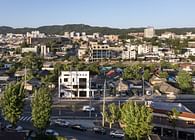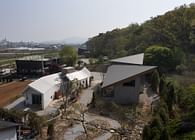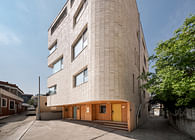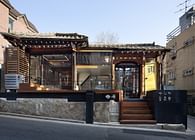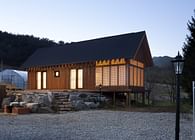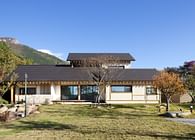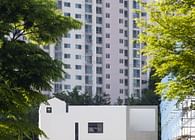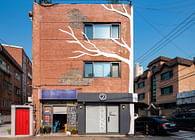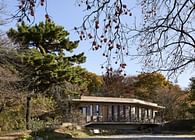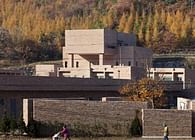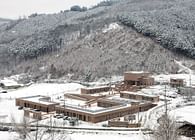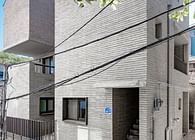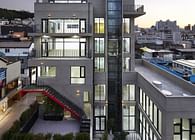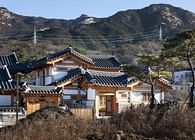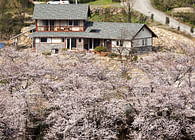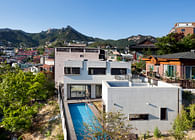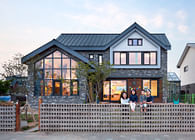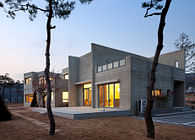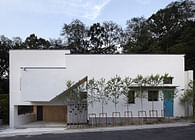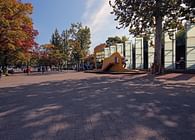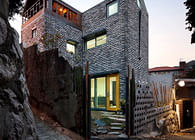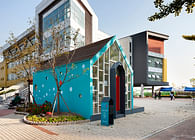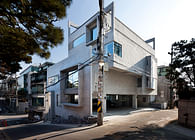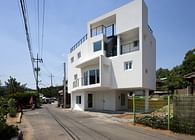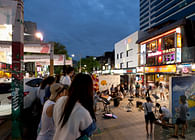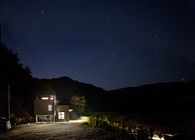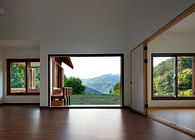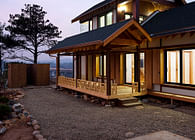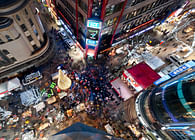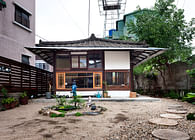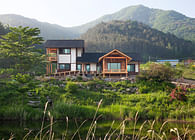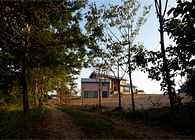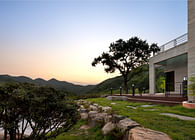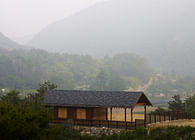
Seoul, KR
The Seomjin River, which starts at Demi Sam(stream) in Jinan, North Jeolla Province, passes through Namwon and Gokseong province, and enters Gurye province, where it merges with the sea at Gwangyang Bay after a long journey. At the end of it sits a village with rocks everywhere. It is a village called Dosari, which is Gwangyang as an administrative district, but is actually close to Hadong across the river.
The region is famous for cornus fruit, which heralds spring, and it is also a place where you can see the gentle ridge of Mount Jiri and the silky Seomjin River simultaneously. As you climb through a neighborhood full of old houses, fruit trees such as plums and persimmons dot the crevices of hills and valleys.
The clients of the < Domus Petra>are devout Catholics, as can be guessed from the name. Jesus gives Simon the name Peter (Peter is a translation of Petrus, which means rock), and tells him that he will build a solid church on the rock. “Build Your House on The rock.” Jesus tells Peter. The house would last a solid and lasting life. Peter created a solid foundation for religion that would last for thousands of years, just as Jesus wanted.
The house on the rock (Domus Petra). We built our house on solid rock. No, we actually dodged the rocks and sat the house down.
The first time we went to the site, we made our way through the grass and into the mountain road, and the rocks around site looked at us with their eyes flashing like soldiers lurking under the grass and plum trees. As we came near the site, the rocks were growing in number. There were so many that we had to give up counting. As you climb up one of the rocks, you will see another rock nearby. There were also stones that looked like dolmens or menhirs that had stood on the ground for a long time. The rocks had been guarding the land for a long time, and they quietly but thunderously revealed themselves, as if to invite us to listen to them.
We watched the flow of the mountains through the rocks and felt the flow of the river. And we saw the landscape between the grass and the trees. Everything had been in place for a long time, in the wind, rain, and snow, and was knitted together as if it had been held together with a strong glue. We squeezed through the cracks and looked for a place for people to sit or lie down.
The site was in the mountains, a little way out of the town of Dosari village. We could see a glimpse of the roof of the barn below the ground, and the houses of the neighborhood were in the distance. It felt like the site was whispering that you just need to get out of the human world and look at Jirisan and the Seomjin River.
The clients who wanted to build a house on this land were a couple in their 60s who had no connection to the original neighborhood. They liked the area around the Seomjin River, so they looked at a few places and settled on the neighborhood where cornus blooms first. This place was overgrown with plum trees, as many as rocks, and was famous for its cornus trees.
Cornus is a very strange tree. It blooms to herald spring, and it blooms like a spray of water, with small, light-yellow powder on the branches that are lightly smeared on the trunk of the tree. "Oh, it's spring. " When the cornus shoots a signal shot, other flowers bloom in all directions, shouting in unison, like soldiers ordered to advance, as if they are awakening and starting to act. Forsythia, azaleas, cherry blossoms, magnolias, and all the other trees whose names we do not know, pull out the brilliant colors that are immersed in them.
Architecture is about extracting beautiful colors that are immersed in the ground. What would be the brilliant colors that are immersed in this earth?
We began to wonder what color to paint between the black and brown colors of the rocks, the vivid grass, and the soft colors of the mountains that enveloped the contrasting colors.
The clients wanted a house that could sustain the simple life of the couple living and looking at the scenery and tending to the plum tree, but the sscope of the house they wanted was not small. It was a place where they could live and continue business for a long time, and they also needed extra rooms for their children or guests to stay when they come to visit. To start a new life, they came to this village in advance, bought an old house, lived there for about a year, mingled with the people in the neighborhood, while thinking about the space they wanted.
When we started designing, we counted the rocks. We laid out aerial photographs, and marked the rocks that we could see at first glance. Of course, these were large boulders captured in aerial photographs, but there were many more indistinguishable rocks at the site. Then we dodged the rocks and laid a plan down. The shape of the site was like a creature with horns and ears, and the path into it was as long as the esophagus. We pondered where house would sit, to coexist with the hidden clearing inside, to harmonize with the land at the right height, and to keep the rocks that bloomed at each border.
Considering the narrow road conditions and the difficulty of construction, a lightweight wooden structure that is easy to transport was chosen. As we dodged the rocks, the house first took the shape of a linear house that went out towards the Seomjin River. The house was placed on a rock that towered with two towers.
The first floor contains public life, and the second floor contains private life. The shape of the plan, which was straight, was slightly bent to consider the rocks and the view, but the design of the space program that was created at the beginning proceeded without major changes. In consideration of the work of tending to the plum trees around the house, a number of entrances to the house was made here and there. A deck was attached to the perimeter of the house where you could approach the house or rest for a while working in the garden, and on the second floor, a space for playing musical instruments was provided.
The house has two main façades. The façade in the direction of entering the house from the driveway and the other direction towards the Seomjin River and Jirisan Mountain, each with a gable-shaped elevation. Then, the shape of house was designed to float on the rocks and towards Mount Jiri with a deck.
Half a year passed with the design, and construction began in the spring.
Originally, we thought of a staircase formed by two huge rock crevices that had been left behind, leading to the deck, and when turning around, a view of the Seomjin River would be revealed. However, when the construction began, and the trees were cut down and the rocks were cleared for vehicles to come and go. The rock, which was supposed to be a gate and a gateway, was pushed away. It is a pity that when construction begins, changes cannot be prevented from happening according to the conditions of the site, contrary to the original plan. The interior design has been preserved almost intact, but the part where it meets the ground, and many of the trees and rocks that should have been left behind, have disappeared.
The living room has two storey heights to create a sense of cool space and views that open in all directions that cannot be felt in apartments with low ceilings. The owners descend from their second-floor bedrooms and circle the walkways around the house, tending to the trees they have left behind, giving them a peace of mind that they could not get from their homes in the city.
Across the river, from Hadong province, you can clearly see the lights of this house. Just as travelers find a twinkling light in the darkness at the end of a long journey, I hope that the owners will find peace in this house on the rock.
Status: Built
Location: Gwangyang, KR
Firm Role: architect
Additional Credits: Architect : Hyoungnam Lim, Eunjoo Roh in studio_GAON
Project Team : Hwawon Kim, Jion Lim
Photographs : Youngchae Park
Location : Dosa-ri, Daap-myeon, Gwangyang-si, Jeollanam-do, Republic of Korea
Use: Residence
Site Area : 885.77㎡
Building Area : 157.94 ㎡
Gross Floor Area : 196.67㎡
Building Scope : 2F
Height : 8.3m
Building-to-Land Ratio : 17.83%
Floor Area Ratio : 22.20%
Structure : Wood Frame Construction
Finish : Brick
Supervision : studio_GAON

